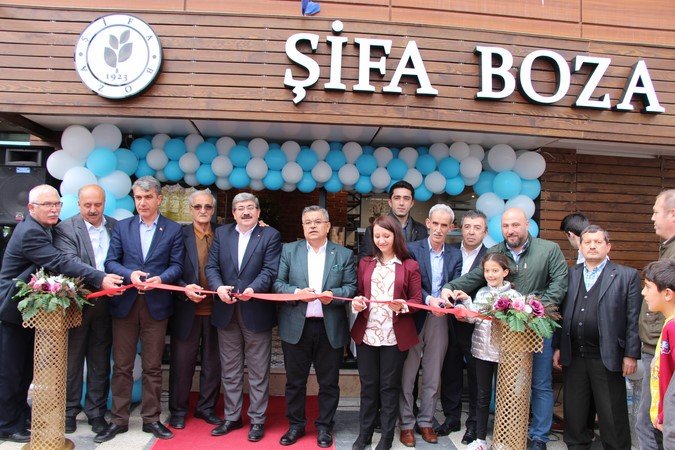Boza, a traditional fermented beverage, has been an essential part of Turkish and Balkan culinary history for centuries. Among the many regional varieties of boza, Pazarcık Şifa Bozası stands out for its unique blend of flavors, historical significance, and the belief in its medicinal benefits. This iconic drink, made from millet, wheat, or corn, has been cherished for its thick consistency, slightly tangy taste, and warming qualities during the winter months.
Pazarcık, a small town in the Kahramanmaraş province of Turkey, is known for producing one of the finest types of boza, named Pazarcık Şifa Bozası. “Şifa” means “cure” or “healing” in Turkish, and the locals have long believed in the health-boosting properties of this version of boza. In this article, we will take an in-depth look at the history, production process, nutritional benefits, cultural significance, and modern-day relevance of Pazarcık Şifa Bozası, as well as how it fits into Turkey’s broader culinary landscape.
1. The Origins and History of Boza
Boza has an ancient history that dates back more than 8000 years. It is believed to have originated in Mesopotamia, where it was initially brewed as a fermented cereal drink. Over time, boza spread to the Balkans, Central Asia, and the Ottoman Empire, becoming a staple drink in many cultures. Its thick texture and mildly sour taste made it a comforting and nourishing beverage, especially during the colder months.
During the Ottoman period, boza became particularly popular among soldiers and laborers because of its high caloric content and its ability to sustain energy for long periods. It was commonly sold in street markets and specialized boza shops, where locals would gather to enjoy the drink in a communal setting. Over the centuries, different regions developed their own variations of boza, each using locally sourced grains and unique fermentation methods.
Pazarcık Şifa Bozası, in particular, has a rich history rooted in the town of Pazarcık, where it is believed to have been produced for centuries as a drink with both nutritional and medicinal properties. The people of Pazarcık have passed down the recipe and method of production from generation to generation, keeping the tradition alive and ensuring that it remains a symbol of their local culture.
2. The Unique Production Process of Pazarcık Şifa Bozası
The process of making Pazarcık Şifa Bozası involves several steps, each of which contributes to the drink’s characteristic flavor and texture. Although the specific recipe may vary slightly depending on family traditions, the essential steps remain consistent across generations.
2.1 Selection of Ingredients
The primary ingredient in Pazarcık Şifa Bozası is millet or corn, though wheat can also be used. The choice of grain has a significant impact on the flavor and texture of the final product. Millet is the most commonly used grain in Pazarcık, as it produces a smooth and creamy consistency with a mildly sweet flavor. Corn-based boza tends to have a slightly thicker texture and a more robust, earthy taste.
2.2 Boiling and Fermentation
Once the grain has been selected, it is boiled in water until it softens and breaks down into a thick porridge-like consistency. This mixture is then left to cool before the fermentation process begins. Yeast is added to the cooled mixture to kickstart the fermentation, which typically takes place over several days in a cool environment. The length of fermentation can vary depending on the desired taste – a longer fermentation time results in a tangier flavor, while a shorter time produces a sweeter, milder drink.
2.3 Sweetening and Flavoring
Once the fermentation process is complete, sugar is added to the boza to balance out the natural sourness. Some producers also add a small amount of cinnamon or vanilla for extra flavor, though this is not a universal practice. Traditionally, Pazarcık Şifa Bozası is served with a sprinkling of roasted chickpeas or cinnamon on top, which adds a delightful textural contrast and enhances the overall flavor profile.
2.4 Storage and Serving
Pazarcık Şifa Bozası is typically stored in glass or clay containers to preserve its freshness and flavor. It is often enjoyed cold during the winter months, though it can be served slightly warmed in some variations. The thick, creamy consistency of the drink makes it a satisfying treat, whether consumed as a beverage or as part of a meal.
3. Nutritional and Health Benefits of Pazarcık Şifa Bozası
One of the reasons Pazarcık Şifa Bozası has remained popular for so long is its reputation as a nutritious and health-promoting beverage. The fermentation process involved in making boza produces beneficial probiotics, which can aid in digestion and support gut health. Additionally, boza is rich in vitamins, minerals, and essential nutrients that make it an excellent choice for anyone looking to boost their energy levels or improve their overall health.
3.1 High in Probiotics
Fermented foods and drinks are known for their probiotic content, and Pazarcık Şifa Bozası is no exception. The live cultures produced during fermentation can help maintain a healthy balance of bacteria in the gut, which in turn supports digestion, boosts the immune system, and may even improve mental health. Regular consumption of boza can help alleviate symptoms of digestive disorders such as bloating, gas, and constipation.
3.2 Rich in B Vitamins
Pazarcık Şifa Bozası is an excellent source of B vitamins, particularly B1 (thiamine) and B2 (riboflavin). These vitamins play a crucial role in maintaining energy levels, supporting brain function, and promoting healthy skin, hair, and eyes. They are also important for proper nerve function and can help prevent conditions like anemia and fatigue.
3.3 A Good Source of Protein and Fiber
Because it is made from whole grains, Pazarcık Şifa Bozası contains a good amount of both protein and dietary fiber. Protein is essential for muscle repair and growth, while fiber supports healthy digestion and can help regulate blood sugar levels. This makes boza a filling and satisfying drink that can be enjoyed as a snack or even as a meal replacement.
3.4 Low in Alcohol
Although boza is a fermented beverage, its alcohol content is extremely low, usually less than 1%. This makes it a safe and family-friendly drink that can be enjoyed by people of all ages, including children and the elderly. The low alcohol content also means that boza can be consumed in larger quantities without causing intoxication or other negative effects associated with alcoholic beverages.
3.5 Boosts Immune System
The combination of probiotics, vitamins, and minerals found in Pazarcık Şifa Bozası can help support a strong immune system. Regular consumption of boza has been linked to improved resistance to infections and illnesses, particularly during the cold and flu season. The warming nature of the drink also makes it a comforting choice during the winter months when the immune system may be more vulnerable.
4. Cultural Significance of Pazarcık Şifa Bozası
Pazarcık Şifa Bozası is not just a drink – it is a symbol of tradition, community, and hospitality in the town of Pazarcık and beyond. For generations, families in Pazarcık have gathered around the table to share boza during the cold winter months, creating a sense of warmth and togetherness.
In Turkish culture, boza has long been associated with hospitality. It is often offered to guests as a sign of respect and generosity, particularly during special occasions and celebrations. Boza sellers, or bozacı, are a common sight in Turkish towns and cities, especially in the winter, when they travel from door to door offering fresh boza to households. This practice has helped to keep the tradition of boza alive, even in the face of modern-day changes to food and drink consumption.
4.1 A Symbol of Turkish Heritage
Boza is deeply intertwined with Turkish cultural heritage, and Pazarcık Şifa Bozası represents a regional variation of this beloved drink. The people of Pazarcık take great pride in their local boza, and efforts have been made to preserve and promote it as part of the town’s cultural identity. Local festivals and events often feature boza as a central element, and visitors to the region are encouraged to try this unique beverage as part of their experience of Turkish cuisine.
4.2 A Modern-Day Revival
In recent years, there has been a renewed interest in traditional foods and drinks, including boza. Health-conscious consumers are increasingly drawn to fermented beverages for their probiotic content and potential health benefits, and Pazarcık Şifa Bozası has gained popularity beyond its regional origins. Artisanal boza producers have emerged in cities across Turkey, offering both traditional and modern variations of the drink to a new generation of boza enthusiasts.
5. How to Enjoy Pazarcık Şifa Bozası
Pazarcık Şifa Bozası can be enjoyed in many different ways, depending on personal preferences and the occasion. Some people prefer to drink it on its own, savoring the rich, creamy texture and slightly tangy flavor. Others like to pair boza with roasted chickpeas, cinnamon, or even a slice of bread for a more substantial snack.
During the winter months, boza is often served as a warming drink to ward off the chill, while in the summer, it can be enjoyed cold as a refreshing treat. No matter how it is served, Pazarcık Şifa Bozası is a versatile and delicious beverage that can be enjoyed at any time of year.
Conclusion
Pazarcık Şifa Bozası is more than just a traditional Turkish drink – it is a testament to the rich cultural history, culinary expertise, and health-conscious traditions of the people of Pazarcık. With its unique production process, nutritional benefits, and deep cultural significance, this regional variation of boza continues to hold a special place in Turkish cuisine and in the hearts of those who enjoy it.
As more people discover the joys of fermented foods and drinks, the future of Pazarcık Şifa Bozası looks bright. Whether enjoyed for its health benefits, its comforting flavor, or its cultural importance, this drink remains a beloved part of Turkey’s culinary heritage – one that is sure to be enjoyed for generations to come.




